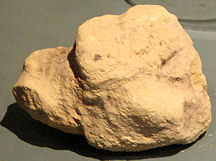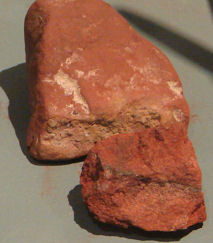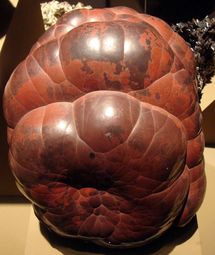Ochre (pronounced OAK-er, and sometimes spelled ocher) is an oxide of iron. It may have a range of colors between yellow (left) and red (right), although the more red variants were usually preferred by peoples who used it prehistorically. In its earliest uses it was unrefined, amounting to little more than brightly colored mud.

Throughout human history ochre was a common pigment for various decorative purposes, including body painting. In the Upper Paleolithic it was prominent among the pigments used in wall art.

Red ochre was often smeared or sprinkled on corpses in European graves from Neanderthal times clear up to the Bronze Age. A common interpretation is that, being approximately the color of blood, ochre was supposed to represent life or to have life-giving qualities.
The term "ochre grave" is sometimes given to graves in which ochre was so thickly smeared on the corpse that after its deterioration the red stain was forever left upon the bones.
Although both colors of ochre (and intermediate colors) are oxides of iron, the conditions, process, extent, and color effects of oxidation differ. In general, red ochre is associated with well drained soils, yellow ochre with damper soils. (Yellow ochre hence is sometimes referred to as "hydrated").

Ochre is usually soft and easily powdered. Denser, more stone-like iron oxide (called hematite or limonite, depending upon its composition) occurs in nodules and was sometimes worked like other stone in prehistoric times.
The word "ochre" comes through late Latin from a Greek word for pale yellow. It is ironic that, as the word is used in English, most ochre is red.
Specimens shown here are in the San Diego Museum of Man
& the L.A. Natural History Museum.
